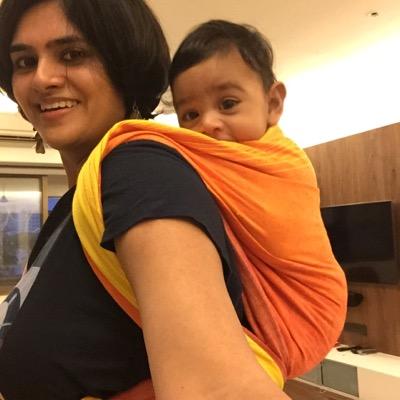
Guest Post – Wear your baby!
Baby wearing – or the practice of carrying your baby/infant/toddler in a sling/wrap/harness that is strapped to your body, may be a practice that has found popularity in recent times, but truth be told, mothers in almost all geographical locations across the world have used this method since ancient times to carry their children and do their work at the same time.
Effective and safe, this method of carrying your child and keeping your hands free and letting your body carry your baby’s weight, is a very good option for new mothers, and old, experienced ones too. The benefits, apart from the fact that you can carry your child easily, are immense. The constant holding of your child – the constant physical contact, will foster long lasting bonds. Also, babies who are colicky will feel some relief as the slight pressure on the tummy will relieve gas and colic pains. The constant movement that a baby will experience when he or she is strapped to the mother or the father will also allow the child to stabilise his or her physical balance quickly.
Baby carriers are also convenient in more ways than one, not only do you have the freedom to move your arms about and your hands are free for any work, you can also take your baby places easily as carriers are easier to manoeuvre as compared to a baby stroller, especially if you are using public transport.
Many mothers use everyday use fabric to carry their children – instead of investing in costly carriers. One can use anything for these DIY carriers – a length of cloth, a dupatta – anything goes, as long as the fabric is tough and can withstand the weight of the child. The benefits of such a carrier is that you can adjust the length as the child grows in size and you can also adjust it to carry the child when he or she is awake or asleep – on your chest, cradled or on your hips. However, the negatives of this is obviously the safety aspect – be very careful that you have tied your wrap or fabric securely as an accident could occur.
Commercially available carriers are many in number and it is essential that you do your research thoroughly before investing in one. Baby carriers are available for newborns, infants and toddlers and there are even those that you can use right from babyhood to toddlerhood. The variety of carriers includes wraps, Mei Tais – which are soft fabric carriers with a shoulder strap and a tie mechanism on the waist; carriers which emulate slings, those with buckles and even pouches. The ring slings like the Maya Wrap are also sturdy when worn right.
Baby carriers can be used by both parents and others of course, and the child can be carried in front or even on the back though only highly experienced adults should carry the child on the back.
When you invest in a baby carrier ensure that the following are taken care of:
The carrier should support your child just as you would hold him/her. This means that the baby’s bottom should be well supported as should the head; which should be free of the carrier, and allowed to rest on your chest, most importantly, facing out and up.
The child’s legs should be placed above his/her bottom – this will ensure hip development is not damaged or hampered in anyway – the baby should be positioned high on your chest, enough so that you can drop kisses on the top of her/his head.
Make sure the baby’s weight is on his/her bottom, not on the legs – this will be ensured if you are carrying the child high up on your chest, as mentioned before.
If the child is older the chances are that they are going to be using a carrier that allows their legs to hang out – be very careful when wearing a baby this way. Make sure the carrier extends support to the child’s knees and again, the knees are positioned higher than the bottom.
Try not to use a carrier that your child will be facing outward in. Outward facing carriers don’t encourage a peaceful time for the baby and also, the child’s neck will hang forward thanks to gravity, without the support of your chest to lean on, thus giving rise to possible neck issues and might also negatively impact a baby’s developing spine and hips.
If you want your child to be looking outward then carry him/her in a high back carrier – where he/she can look over your shoulder while strapped on your back.
Always make sure your child can breathe easily and freely – if his or her head is tucked into his chin then it will hamper breathing and restrict the airway which will cause many serious problems. For the same reason, don’t cover the child’s head with fabric or cloth.
Your baby might be in a carrier strapped to your chest, but that doesn’t mean you run, jump or walk briskly so that the child is jerked around. Be very careful, as careful as you would be if you were carrying the child physically because jerky movements will damage the soft neck of the baby
Babies have been worn by mothers through the passage of time. So if anyone tells you not to carry your baby as you will spoil them the next time, tell them that it’s your baby’s birthright and wear your baby with pride!
Guest article from www.glad2bawoman.com. Glad2bawoman is an online media company for women with over 77,000 members. The articles on their site encompass various topics around Health, Empowerment, Relationships, Leisure and Fashion.


 Follow
Follow









